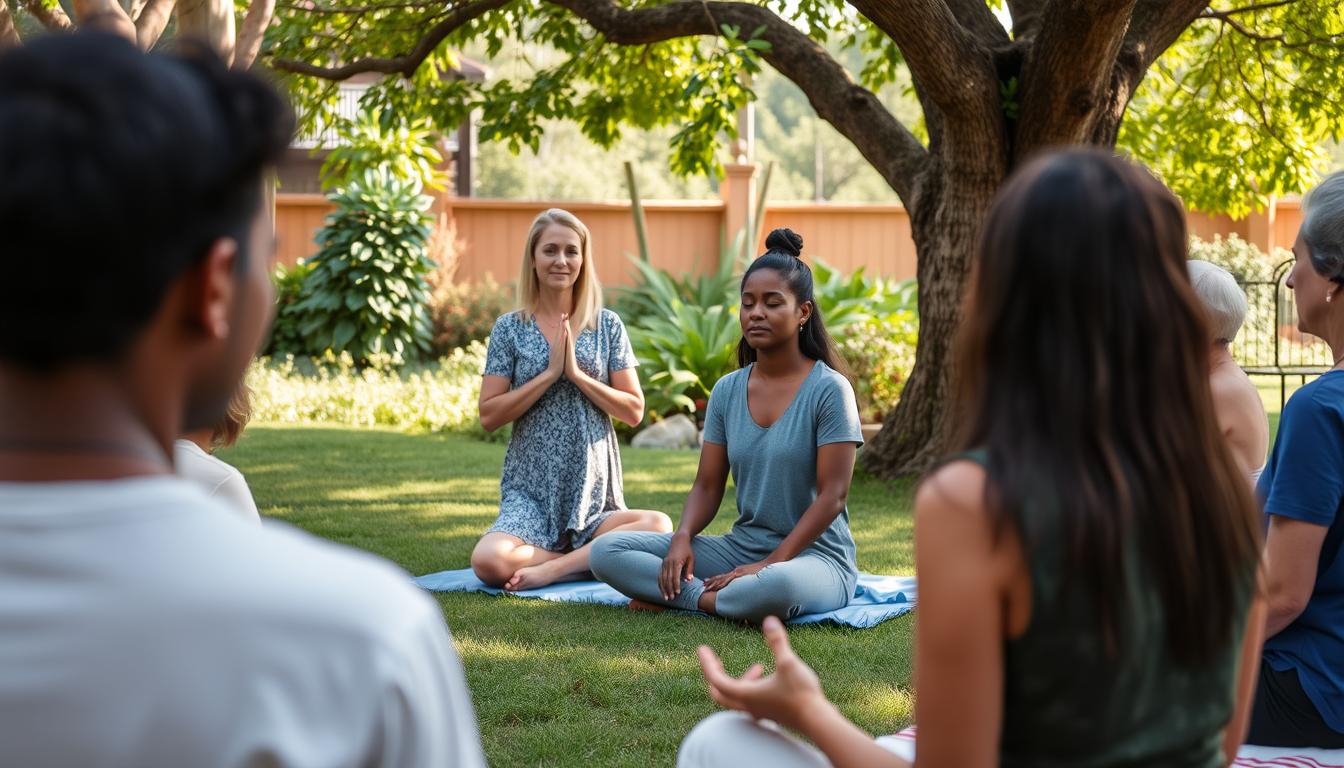Emotional healing retreats give people a chance to reconnect with themselves. They help rebuild emotional strength and restore balance. These retreats offer a safe space to explore emotions, gain insights, and learn coping strategies.
By going to an emotional healing retreat, you can grow deeply and transform. This can lead to a more fulfilling life. These retreats help people let go of past traumas and negative patterns.
A serene forest landscape with a tranquil meditation space, surrounded by lush greenery, soft sunlight filtering through the trees, a gentle stream flowing nearby, inviting seating arranged in a circle with cushions, and an atmosphere of peace and healing.
At emotional healing retreats, you can reconnect with your feelings, thoughts, and actions. You’ll gain a deeper understanding of yourself. This journey of self-discovery and healing can change your life.
It allows you to find your purpose and direction again. By reconnecting with yourself and others, you can regain emotional balance. This leads to a happier and more satisfying life. Emotional healing retreats are a powerful tool for personal growth, helping you find your inner strength and resilience.
Key Takeaways
- Emotional healing retreats provide a safe and supportive environment for personal growth and transformation
- These retreats help individuals reconnect with their emotions, thoughts, and behaviors
- Emotional healing retreats offer a unique opportunity for self-discovery and healing
- By attending a retreat, individuals can rebuild their emotional strength and restore inner balance
- Emotional healing retreats can be a powerful catalyst for personal growth and transformation
- These retreats help individuals develop coping strategies and gain insight into their emotions and behaviors
Understanding Emotional Healing Retreats
Emotional healing retreats are places where people can mend their inner selves. They offer a space where you can focus on your mental and emotional health. This is without the daily distractions that usually get in the way.
What Defines an Emotional Healing Retreat
An emotional healing retreat is different from other wellness programs. It focuses on emotional challenges. These retreats use therapy, guided activities, and community support to help you grow.
The Science Behind Emotional Healing
Science backs the effectiveness of emotional healing techniques in retreats. Mindfulness, meditation, and cognitive behavioral therapy (CBT) are proven to help. They reduce stress, improve emotional control, and boost mental health.
Core Principles of Emotional Recovery
- Self-awareness: Understanding your emotions and what triggers them.
- Mindfulness: Being present and fully engaged in the moment.
- Resilience: Learning to bounce back from emotional challenges.
- Support: Connecting with others who are also healing.
The Transformative Power of Healing Retreats
Emotional healing retreats are a safe place for those looking to grow deeply. They offer a break from daily stress. This allows people to focus on their inner health and start a journey of self-discovery.
Many have seen big changes after going to healing retreats. For example, Jane Smith found her purpose again after a retreat in Bali. She learned to handle stress better and found her passions again, leading to a more balanced life.
These retreats offer many activities to help with emotional healing. You might find guided meditation, group therapy, and nature walks. These activities help create a space where people can share their feelings and work on their challenges.
People often say they feel better for a long time after these retreats. They feel more emotionally strong, their relationships improve, and they understand themselves better. Healing retreats help people make lasting changes in their lives.
- Personal growth and self-awareness
- Improved emotional well-being
- Lasting positive changes in daily life
The real power of healing retreats is in their ability to create a space for true healing and growth. By spending time at these retreats, people can heal emotionally. This leads to a more fulfilling life.
Types of Emotional Healing Retreats
Emotional healing retreats offer many ways to help you feel better. Knowing what’s out there can help you pick the right one for you.
Group Healing Experiences
Group healing experiences create a supportive community. Sharing with others who face similar issues can help you feel connected. These retreats include group activities, discussions, and workshops to help everyone heal together.
Individual Therapeutic Retreats
Individual therapeutic retreats focus on your personal healing plan. You get one-on-one time with experts to tailor your support. This is perfect for those wanting deep therapy and a private healing space.
Specialized Trauma Recovery Programs
Specialized trauma recovery programs tackle specific emotional traumas. They use proven methods to help you deal with deep emotional wounds. You might do cognitive-behavioral therapy or somatic experiencing.
Nature-Based Healing Journeys
Nature-based healing journeys use nature’s power to heal. You might go hiking, meditate outdoors, or do eco-therapy. These retreats help you connect with nature and find peace.
| Type of Retreat | Description | Key Benefits |
|---|---|---|
| Group Healing Experiences | Communal settings with shared activities and support. | Community support, shared experiences, collective healing. |
| Individual Therapeutic Retreats | Personalized one-on-one therapy sessions. | Customized support, privacy, focused healing. |
| Specialized Trauma Recovery Programs | Targeted programs for specific emotional traumas. | Evidence-based therapies, specialized support, deep healing. |
| Nature-Based Healing Journeys | Healing activities conducted in natural environments. | Connection with nature, stress reduction, inner peace. |
Essential Components of a Healing Journey
Starting an emotional healing journey involves several important parts. A supportive environment is key, offering a safe place where people feel understood and accepted.
Skilled facilitators are crucial, guiding with their knowledge to make healing personal and effective. They help navigate the complex world of emotional healing.
Using proven healing techniques, like mindfulness and cognitive therapies, boosts the healing journey. These methods help in emotional recovery and building resilience.
Self-reflection and personal growth are also vital. They let people delve into their emotions, finding ways to cope and improve their well-being over time.
These elements together form a complete and effective healing experience. They empower people to reconnect, rebuild, and restore their emotional health.
A serene landscape featuring a tranquil lake surrounded by lush forests, soft sunlight filtering through the trees, a gentle breeze creating ripples on the water’s surface, stones arranged in a harmonious circle along the shore, and wildflowers blooming nearby, evoking a sense of peace and emotional renewal.
| Component | Role in Emotional Healing |
|---|---|
| Supportive Environment | Creates a safe and accepting space for healing. |
| Skilled Facilitators | Provide expertise and personalized guidance. |
| Evidence-Based Techniques | Utilize proven methods to support emotional recovery. |
| Self-Reflection Opportunities | Encourage deep emotional exploration and growth. |
Preparing for Your Emotional Healing Retreat
Starting emotional healing retreats is a big step towards personal growth. Getting ready well helps you make the most of it.
Mental Preparation Steps
Begin by setting clear goals. Think about what you want to achieve and any worries you have.
- Write down your thoughts and feelings.
- Do mindfulness or meditation every day.
- Talk to friends or a therapist for support.
Physical Readiness Guidelines
Make sure your body is ready too. Being physically well helps with emotional healing.
- Drink plenty of water and eat healthy.
- Do some light exercise regularly.
- Get enough sleep before the retreat.
What to Pack and Bring
Having the right things can make your retreat more comfortable and helpful.
| Category | Items |
|---|---|
| Clothing | Comfortable outfits, yoga wear, pajamas |
| Personal Items | Journal, pens, meditation cushion |
| Health Essentials | Reusable water bottle, any necessary medications |
The Role of Professional Facilitators
Professional facilitators are key to emotional healing retreats. They use their knowledge and experience to guide participants on their healing path.
A serene environment with a calm facilitator guiding a group of diverse individuals through a gentle outdoor meditation session, surrounded by lush greenery and soft natural light, evoking feelings of connection, safety, and emotional release.
These experts have many qualifications. They are certified in therapeutic practices and have a lot of training in emotional healing. Their skills make sure each retreat is safe and works well.
Facilitators are great at working with people. They create a supportive space. They listen well, offer personal advice, and help people deal with their feelings.
- Fostering a nurturing relationship
- Providing tailored healing strategies
- Ensuring a safe and open space for sharing
Their hard work and caring attitude really help. They help people connect, rebuild, and find their emotional strength again.
Healing Techniques and Modalities
Emotional healing retreats use many techniques to help you feel better. These methods cover different healing aspects, making sure you get a full recovery.
Meditation and Mindfulness Practices
Meditation calms your mind and boosts self-awareness. Mindfulness helps you stay in the present, lowering stress and improving emotional balance. Regular practice can bring lasting emotional healing.
Somatic Experiencing
Somatic experiencing links your body and mind. It helps release tension and trauma, leading to physical and emotional healing. By paying attention to your body, you can process and overcome past experiences.
Energy Healing Methods
Energy healing balances your body’s energy fields for better well-being. Techniques like Reiki and chakra balancing aim to remove blockages, helping emotional healing. These practices help your body heal and restore emotional balance.
Creating Lasting Change After Your Retreat
Coming home from an emotional healing retreat is a great chance to keep moving forward. By using good integration practices, you can make sure the positive changes last.
Integration Practices
Start daily routines that remind you of what you learned at the retreat. Simple things like morning meditation or writing in a journal can help keep your progress.
Building Support Systems
Reach out to friends, family, or support groups who get what you’re going through. Sharing your story can give you support and keep you on track.
A serene landscape featuring a tranquil lake surrounded by lush greenery, with soft sunlight filtering through trees, and individuals sitting peacefully on a grassy shore, engaging in mindful practices like meditation and gentle yoga, emphasizing unity and connection, reflecting a sense of emotional healing and tranquility.
Maintaining Emotional Balance
Be aware of your feelings and what sets them off. Make sure to take care of yourself with activities like exercise, healthy eating, and enough sleep.
The journey doesn’t stop when the retreat is over. Keep looking for ways to reconnect with yourself and grow from your emotional healing retreats.
Choosing the Right Retreat Location
Finding the perfect spot is key for a great emotional healing retreat. The setting greatly affects your healing journey.
Think about the natural beauty around you. A calm environment with nature nearby can boost your healing. Look for places near forests, beaches, or mountains for peace.
There are many types of places to stay. Pick one that feels right to you, like a cozy cabin or a modern lodge. Feeling comfortable is important for a good stay.
Getting there should be easy. Make sure the retreat is simple to reach by car, train, or plane. Easy access helps you focus on healing without stress.
The weather matters too. Choose a place with a climate you like, whether it’s warm or cool. A good climate helps you feel better overall.
- Natural surroundings
- Accommodation types
- Accessibility
- Climate
By carefully thinking about these points, you can find a place that fits your needs and healing goals. This ensures a powerful emotional healing retreat.
Conclusion: Embracing Your Healing Journey
Starting an emotional healing journey can change your life in big ways. Emotional trauma healing retreats are a safe place to find yourself again. They help you build inner strength and offer the tools for real healing.
We’ve looked at many parts of emotional healing in this article. This includes the science behind it and the different types of retreats. Going to a healing retreat is a big step towards feeling better emotionally.
Think about moving forward in your healing journey. Look into the many emotional trauma healing retreats that can help you change for the better. Take the chance to grow personally and find the peace and balance you’ve been missing.
Your emotional healing journey is special, and a retreat can be the ideal place to support it. Begin today and invest in your well-being for a brighter, healthier future.
FAQ
What are emotional healing retreats?
Emotional healing retreats are special programs. They help people connect with themselves again. They rebuild emotional strength and find inner balance.
These retreats offer many healing practices. They also have a supportive environment for personal growth and well-being.
How do emotional healing retreats facilitate reconnection?
These retreats offer a peaceful place away from daily stress. This lets people focus on themselves.
Through meditation, mindfulness, and group talks, people can reconnect with their feelings. They also gain deeper self-awareness.
What types of emotional healing techniques are used in these retreats?
Retreats use many techniques. These include meditation, mindfulness, somatic experiencing, and energy healing. They also have therapeutic sessions.
These methods help deal with emotional trauma. They promote holistic healing.
Who can benefit from attending an emotional trauma healing retreat?
People facing emotional challenges can benefit. This includes stress, anxiety, grief, or past trauma. These retreats offer a safe space to process emotions.
They help find coping strategies. They start a journey of emotional recovery.
How should I prepare for an emotional healing retreat?
Mental and physical readiness are key. Set clear intentions for your healing journey. Address any concerns beforehand. Make sure you’re in good health.
Packing essentials like comfy clothes, journals, and personal items can improve your experience.
What can I expect during a healing retreat?
Expect a structured yet flexible schedule. It includes therapy sessions, group activities, mindfulness, and time for reflection.
The supportive community and professional facilitators guide you. They help you through your healing process.
How do emotional healing retreats create lasting change?
These retreats focus on integration. They help develop support systems and maintain emotional balance after the retreat.
They provide tools and strategies for ongoing self-care. This helps sustain positive changes and continue personal growth.
What should I look for when choosing an emotional healing retreat location?
Look at natural surroundings, accommodation types, accessibility, and climate. A serene environment that fits your preferences can enhance your healing experience.



